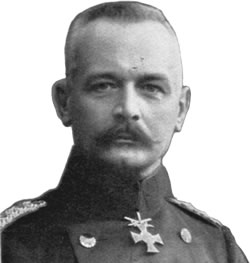 Aims of the German Supreme Command
Aims of the German Supreme Command
13 April 1915
From early 1915 the Chief of German General Staff, General Erich von Falkenhayn, had decided that, for the foreseeable future, it was not going to be possible to force a decision against the enemy on his western battle front. By early April he had focused his attention on the possibility of striking a blow against Russia, with the aim of permanently crippling her offensive powers.

|
On 13th April 1915 General von Falkenhayn sent a telegram(1) from his headquarters in Charleville-Mézières to General von Conrad at Teschen on the Eastern Front. It was a plan of operations for a breakthrough of the Russian line on the Galician front. The plan was shrouded in secrecy and would involve German and Austro-Hungarian troops.
Studying Allied Troop Strength on the Western Front
According to the German official military history “Der Weltkrieg” (2) at the end of March 1915 German Supreme Command had been examining intelligence documents about the forecasted growth of the Allied troop strength during the coming summer of 1915.
British Army
The German consideration was that the British First Kitchener's Army would not be in a position to take to the field until early April, with the Second and Third Kitchener's Armies following on after the summer. It was considered that there would be a minimum of four Kitchener's Armies with six divisions. It was anticipated that during the summer months Canadian and Indian troops were likely to be added to the British contingent in France.
French Army
German Supreme Command reckoned that in France about 180,000 men, who had come of age, could be called to arms from the beginning of April. After training they would be ready for active service in 1916. It was considered that the French could call up three new army corps using every available man who was eligible or capable of fighting from April 1915.
Belgian Army
The Germans did not believe that the Belgian Army was in a position to strengthen its numbers.
Maintaining an “Active” Defence on the Western Front
Although he had decided to concentrate his effort on the Eastern Front for the spring of 1915, Falkenhayn was not prepared to let the enemy gain the upper hand in any way on his western battle front. Neither was he content to allow the German troops to simply sit quietly on the defensive. Orders were issued to the German Armies on the western front to make small attacks to keep the enemy on his guard, to build up the trenches and generally to maintain a certain amount of activity opposite the enemy lines.

Maintaining activity on the Western Front would also serve to disguise the removal of any troops who would be moved out of the line to be transported to the Eastern Front. In his book “General Headquarters and its Critical Decisions” General Falkenhayn wrote:
“Lively activity in the positions along the whole Western Front, combined with attacks, in so far as the modest numbers remaining there permitted, were to cloak the transportation of the troops to Galicia.” (3)
Two Aims for the Attack at Ypres
The possible capture of Ypres and a shortening of the German line were not the objectives of the operation at Ypres for German Supreme Command. As far as General von Falkenhayn was concerned, an attack by the 4th Army on the Allied Ypres Salient had two aims:
- to test the first use of poisonous gas by the German Army.
- to divert attention away from his proposed offensive on the Eastern Front.
Next>> German deserter reveals plan to attack with gas
Acknowledgements
(1) General Headquarters 1914-1916 and its Critical Decisions, p. 83
(2) Der Weltkrieg 1914-1918, Band 8, pp. 34-49
(3) General Headquarters 1914-1916 and its Critical Decisions, p. 84